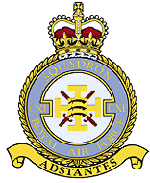| No. 111 Squadron RAF | |
|---|---|
 | |
| Active | 1 August 1917 – 1 April 1918 (RFC) 1 April 1918 – 1 February 1920 (RAF) 1 October 1923 – 12 May 1947 2 December 1953 – 30 September 1974 1 October 1974 – 22 March 2011 |
| Country | |
| Branch | |
| Nickname(s) | 'Treble One' 'Tremblers' |
| Motto(s) | Latin: Adstantes ("Standing by")[1] |
| Battle honours | Palestine 1917–1918*, Megiddo, Home Defence 1940–1942*, France and Low Countries 1940, Dunkirk*, Battle of Britain 1940*, Fortress Europe 1941–1942*, Dieppe, North Africa 1942–1943*, Sicily 1943, Italy 1943–1945*, Salerno, Anzio and Nettuno, Gustav Line, France and Germany 1944*. Honours marked with an asterisk are those emblazoned on the Squadron Standard |
| Insignia | |
| Squadron Badge | In front of two swords in saltire a cross potent quadrat charged with three seaxes fesswise in pale[2] |
| Squadron Roundel | |
| Squadron Codes | TM (Apr 1939 – Sep 1939) JU (Sep 1939 – May 1947) B (Carried on Phantoms) H (Carried on Tornados) |
Number 111 (Fighter) Squadron, also known as No. CXI (F) Squadron and nicknamed Treble One, was a squadron of the Royal Air Force. It was formed in 1917 in the Middle East as No. 111 Squadron of the Royal Flying Corps during the reorganisation of the Egyptian Expeditionary Force after General Edmund Allenby took command during the Sinai and Palestine Campaign. The squadron remained in the Middle East after the end of the First World War until 1920 when it was renumbered as No. 14 Squadron.
The squadron was reformed in 1923. In World War II in 1940, it fought in the Battle of Britain. In late 1941 it moved to the Mediterranean, where it was involved in the North African Campaign and then the Allied invasion of Sicily and the Allied invasion of Italy. Disbanded in the years after the war, the squadron reformed in 1953 with jets.
Operating the Hawker Hunter, No. 111 Squadron provided an aerobatic display team – the Black Arrows. It also performed aerobatics when it re-equipped with the Lightning interceptor. The Squadron moved to Scotland in 1975, shortly after changing to flying Phantoms. In 1990 the squadron began flying the air defence variant of the Panavia Tornado. It operated the Panavia Tornado F3 in air defence from RAF Leuchars, Scotland until March 2011, when the squadron was disbanded, ending Tornado F3 service in the RAF.[3]
© MMXXIII Rich X Search. We shall prevail. All rights reserved. Rich X Search
